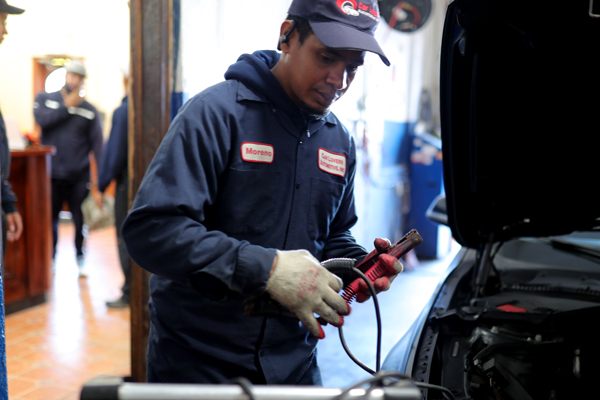All Categories
Featured

[/image]
Appropriate tire maintenance is crucial to extending the life of your car and ensuring a smooth and secure driving experience. Two of one of the most vital tire solutions are tire rotation and placement. These services not just prevent premature tire wear however also improve handling, fuel performance, and general safety and security. If you're not familiar with what tire rotation and alignment require, here's a comprehensive consider why they matter and exactly how they benefit your car.
What Is Tire Turning? Tire rotation describes moving your tires from one setting to one more to guarantee they put on evenly. The reason tire turning is required is due to the fact that not all tires wear similarly. In front-wheel-drive automobiles, for instance, the front tires manage both steering and power, that makes them break faster than the back tires. The back tires use in a different way in rear-wheel-drive and all-wheel-drive vehicles.
By rotating your tires consistently, you can balance out the wear across all 4 tires. This helps them last longer and enables more also grip, improving handling and stability. Many makers suggest revolving your tires every 6,000 to 8,000 miles or according to the lorry's guidebook.
What Is Tire Alignment? Tire alignment, additionally called wheel placement, describes the procedure of readjusting the angles of your cars and truck's wheels to meet the supplier's requirements. The objective of positioning is to ensure that all 4 tires are directing in the best instructions and at the appropriate angles, which permits ideal handling, safety and security, and tire life.
There are 3 main placement angles that are adjusted during a placement check:

Camber: The tilt of the wheels when watched from the front. If the camber is off, it can bring about unequal tire wear, as the tire will certainly not make complete call with the roadway surface area. Caster: The angle of the guiding axis when viewed from the side. Correct wheel positioning makes sure that your car is steady when driving straight which your wheel returns to its typical placement after a turn. Toe: The angle at which the tires direct inward or outside when viewed from above. Incorrect toe alignment can create the tires to drag, resulting in irregular wear and reduced gas efficiency. Misalignment can take place with time due to typical driving or from striking barriers like visuals or holes. If your alignment is off, it's important to obtain it examined and corrected to stay clear of concerns in the future.
Why Tire Turning and Positioning Issue. Enhanced Tire Life:. Regular tire turning ensures also tire wear, assisting you get one of the most mileage out of your tires. Irregular wear can trigger you to replace tires too soon, which can be expensive. When your tires put on uniformly, they last much longer, conserving you cash in the long-term.
Improved Lorry Handling:. Proper alignment keeps your lorry driving straight and stable, specifically at greater speeds. Imbalance can trigger your automobile to pull to one side, making it harder to guide. By maintaining your tires straightened, you guarantee your vehicle handles a lot more smoothly and predictably.
Improved Safety:. Tires that are not rotated or lined up properly can put on unevenly, impacting exactly how well your vehicle stops and edges. Misaligned tires or tires with irregular wear patterns might trigger lowered traction, specifically in damp or icy problems, leading to a greater threat of crashes.
Much Better Fuel Efficiency:. Tires that are misaligned can create rolling resistance, meaning your engine needs to work tougher to move the automobile. This enhances gas consumption and reduces your auto's fuel efficiency. Appropriate tire alignment lowers rolling resistance, which can improve gas mileage.
Indications Your Tires Need Rotation or Alignment. While it's important to stay on top of normal tire turnings and alignments, there are a few indicators that may suggest your tires need interest:
Unequal Wear: If you observe that a person tire is a lot more used than the others, it's likely time for a rotation. Guiding Pull: If your auto pulls away or feels off-center, maybe a sign of imbalance. Vibrations: If you feel vibrations in the guiding wheel or the automobile, maybe because of a positioning problem. Noisy Tires: Squealing or loud tires might show incorrect rotation or imbalance. If you observe any one of these indications, it is very important to get your tires examined by a professional.
How Commonly Should You Turn and Align Your Tires? Tire rotation need to generally be done every 6,000 to 8,000 miles, though this can vary based on your driving conditions and the kind of car you drive. It's additionally a good idea to have your tires rotated whenever you get an oil change.
For positioning, you need to have your tires lined up every 1-2 years, or much more often if you observe any type of issues with dealing with or irregular tire wear. If you hit a big pocket or aesthetic, it's important to obtain a positioning examine today.
Conclusion: Regular Upkeep for Optimum Performance. Tire turning and positioning are 2 simple yet vital services that keep your car running efficiently, efficiently, and safely. By rotating your tires consistently and keeping your wheels effectively aligned, you can extend the life of your tires, enhance handling, and delight in far better gas efficiency.
Latest Posts
Discover Outstanding Vehicle Maintenance Care in Chicago – Drive with Confidence
Uncover Cost-Effective Auto Repairs with Montclare’s Limited-Time Service Specials
Find Brake Repair & More: Complete Services Guide from Montclare Auto Repair
More
Latest Posts
Discover Outstanding Vehicle Maintenance Care in Chicago – Drive with Confidence
Uncover Cost-Effective Auto Repairs with Montclare’s Limited-Time Service Specials
Find Brake Repair & More: Complete Services Guide from Montclare Auto Repair